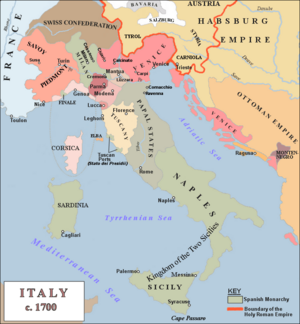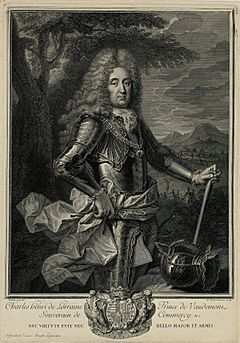Convention of Milan facts for kids

Italy 1700; Spanish-controlled territories in green
|
|
| Signed | 13 March 1707 |
|---|---|
| Location | Milan |
| Original signatories |
|
| Parties | |
| Languages | French |
The Convention of Milan was an important agreement signed on 13 March 1707. It happened during a big war called the War of the Spanish Succession. This agreement was made between France and Austria. It officially stopped the fighting in Northern Italy.
Thanks to this agreement, French soldiers could leave Italy safely. In return, they gave control of all the towns they still held to the Austrian commander, Prince Eugene of Savoy.
Contents
Why was the Convention of Milan needed?
How Spain controlled Italy
For a long time, since 1559, Habsburg Spain was very powerful in Italy. They controlled many important areas like the kingdoms of Sardinia, Naples, and Sicily. They also held lands in northern Italy, especially the Duchy of Milan.
But by the year 1700, Spain's power was getting weaker. People in Italy were also unhappy because they had to pay high taxes for Spain's wars. Also, a new power, Savoy, was becoming stronger.
The start of the Spanish Succession War
In November 1700, Charles II of Spain died without any children. He was the last ruler from the House of Habsburg in Spain. He decided that his throne should go to Philip of Anjou. Philip was the grandson of the powerful French king, Louis XIV of France. So, Philip became the new King of Spain.
In early 1701, French troops took control of Milan and Mantua for Philip. King Louis XIV also made an alliance with Victor Amadeus of Savoy. Victor Amadeus's daughter, Maria Luisa, married Philip. These actions made other European powers worried, leading to the War of the Spanish Succession in July 1701.
Fighting for control of Italy
Having Milan and Mantua allowed the French and Spanish, known as the Bourbon alliance, to threaten Austria. Austria was the main land of the Habsburg monarchy. Because of this, Emperor Leopold sent his best general, Prince Eugene of Savoy, to Italy. By February 1702, Prince Eugene had taken back most of Lombardy.
However, Austria faced money problems in 1703. Also, a revolt in Hungary forced Emperor Leopold to pull back some of his troops. This allowed the French and Spanish to win back some of their lost areas.
In October 1703, Victor Amadeus of Savoy changed sides and joined Austria. But by early 1705, Savoy was almost defeated. So, Emperor Joseph, who became emperor after his father, sent Prince Eugene back to Italy. Much of Eugene's army was made up of German soldiers paid for by England and the Dutch Republic.
With their help, Prince Eugene won a big victory at the Siege of Turin in September 1706. He then captured Milan. Even though the French had a small win at Castiglione on 8 September, their forces in Italy were now cut off from France. In February 1707, Modena surrendered to Austrian forces. This left Mantua as the only major city still held by the French and Spanish.
What did the Convention of Milan say?
The War of the Spanish Succession was fought in several different places. The most important areas were Northern Italy, the Low Countries (like Belgium and the Netherlands), and Spain. In Spain, the Allies (like Austria and England) supported Archduke Charles. He was Emperor Joseph's younger brother and also wanted to be King of Spain.
However, the Austrian Habsburgs thought Italy was more important for their long-term safety than Spain. They refused to give up Naples, Sicily, and Milan to France. This disagreement led to the failure of an earlier treaty in 1700 and started the war in 1701.
By 1706, the French and Spanish alliance was in trouble. They suffered a big defeat in Flanders at the Battle of Ramillies in July. In Spain, the Allies captured Madrid but had to leave in October. Because they were winning in Northern Italy, the Allies planned to attack the French naval base at Toulon. Savoyard and Austrian land forces would work with the Royal Navy (British navy) for this attack.
Capturing Toulon would give the Allies control of the western Mediterranean Sea. It would also help a Protestant revolt in Southern France and force the French to move troops away from Spain. Plus, it would help Savoy get back its lands like Villefranche and the County of Savoy that France had taken.
King Louis XIV of France decided to stop fighting in Italy. He started talking with Emperor Joseph. He used Prince de Vaudémont to help with the talks. Vaudémont was the last Spanish governor of Milan. From his base in Mantua, Vaudémont secretly talked with Prince Eugene during the winter of 1706-1707. They discussed how to get all French and Spanish troops out of Italy.
On 13 March 1707, they signed the Convention of Milan. This agreement allowed all remaining French and Spanish soldiers to leave Italy and go back to France safely. In return, Vaudémont gave the Spanish areas of Milan and Mantua to Austria.
What happened after the Convention?
The Convention of Milan was a good deal for Emperor Joseph. It gave Austria control of Italy without much more fighting or cost. This made good strategic sense for Austria. However, Austria's allies were very angry.
England and the Dutch Republic had paid for most of Prince Eugene's army. Victor Amadeus of Savoy had hoped to gain Milan for himself. But the Convention allowed France to take almost 30,000 soldiers out of Italy. These soldiers were then used in other places.
Many of the troops who left Italy played a key role in stopping the Allied attack on Toulon in August 1707. Marlborough, a famous British general, thought this was a major defeat for the Allies. It ended their hopes of attacking France through its weaker southern border. Instead, the Allies had to fight a long, difficult war on France's strong northern border.


